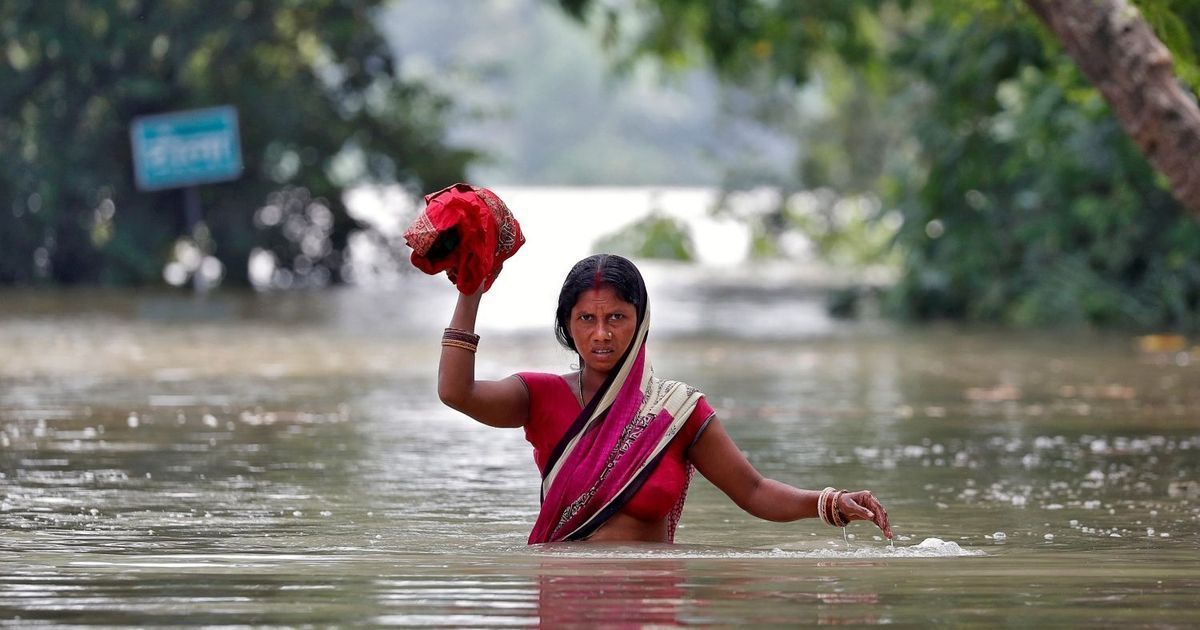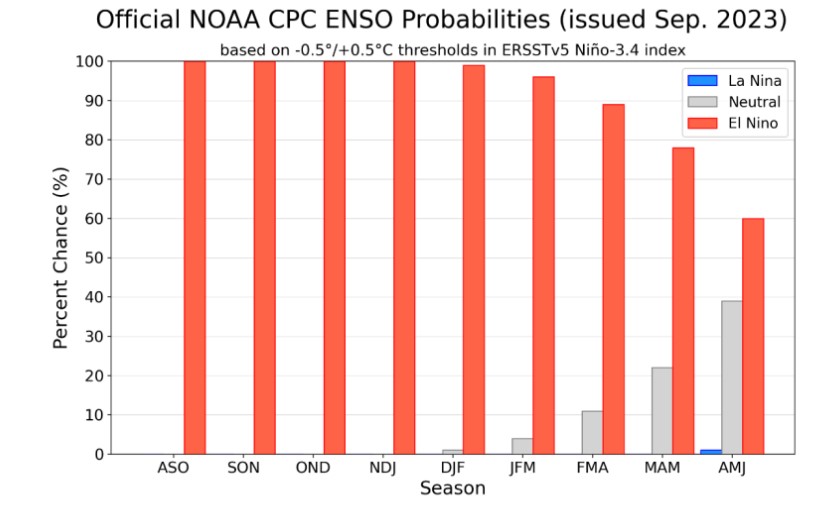Monsoon 2023 ends with below-normal rains, climate change fuels erratic weather
Monsoon 2023 ended with below normal rains to the tune of 6%, courtesy the building El Nino in the Pacific Ocean. Climate change continues to impact spatial variability, which can cause more droughts or floods, posing water and food security challenges.
By Kartiki Negi / Oct 4, 2023

Image Courtesy: Scroll.In
The Southwest Monsoon 2023 ended on September 30, with India ending the season as ‘Below-Normal’. As of September 30, countrywide cumulative rainfall deficiency for the country stood at 6% of the long-period average (LPA) of the total rainfall for the season. The country has recorded a total of 820.0 mm of rain against the normal average of 868.6 mm.
Monsoon 2023 began its journey under the shadow of evolving El Nino in the Pacific Ocean. Experts have already warned of less Monsoon rains during the second half when El Nino gains intensity. Nonetheless, the Monsoon is in itself a strong phenomenon that can drive the rains. That is what we saw in September, with two low-pressure areas reviving the monsoon rains, saving the country from drought.
Extreme weather events continued to govern the four-month-long season. After a sluggish start due to delayed Monsoon onset and slow progress resulted in deficit rainfall in June to the tune of 10%. Cyclone Biparjoy which emerged in the Arabian Sea, was responsible for initiating the onset of the Monsoon over Kerala. However, as it intensified, it took away all the moisture from the country and stalled the progress as well as the performance of the Monsoon in June, resulting in double-digit deficiency. The absence of Monsoon rains also paved the way for humid heatwaves across East India, a phenomenon which is becoming worse due to global warming with excessive evaporation and moisture in the atmosphere. July witnessed rains across the country, except in East and Northeast India.
Large intra-seasonal variations marred the second half of the 2023 monsoon season. The core monsoon month of August accounted for an all-time low of the century in cumulative rainfall, on account of prolonged ‘break monsoon’ conditions. Gujarat reported rainfall deficiency of 90.67%, followed by Kerala at 86.61%, Rajasthan at 80.15%, Karnataka at 74.16%, and Telangana at 64.66%.
With disappointing performance in August, the threat of drought was looming large over the country. However, Monsoon rains revived during the second week of September, courtesy trail of monsoon systems in the Bay of Bengal. Monsoon rainfall deficiency recovered from -11% on September 1 to -6% on September 30.

Region-wise performance
Major contributors in the Monsoon rainfall that include parts of South Peninsula India and East & Northeast India remained deficit throughout the season. State-wise, Kerala reported rainfall deficiency as high as -36%, followed by Jharkhand at -27% and Bihar -24%.
Out of 36 meteorological subdivisions in the country, 26 subdivisions recorded normal rainfall, constituting 73% of the area of the country. Meanwhile, seven subdivisions recorded deficit rainfall that covers 18% of the area of the country. Only three subdivisions witnessed excess rainfall amounting to an area of 7%.
Meanwhile, major contributions in the Monsoon 2023 came from unusual regions of the country like West Rajasthan, which recorded 42% of excess rainfall, Saurashtra and Kutch region in Gujarat reported 48% of excess rains, Himachal Pradesh 19%, and Telangana 15%. However, it is worth noting that these excess rains were all due to very heavy to extremely heavy rainfall events throughout the season.

Climate change Impact
While the waxing and waning of Monsoon rainfall is very normal, climate change has doubled the variability factor of any weather event, be it extreme rains or heatwaves. The once-anticipated summer monsoon is becoming increasingly erratic and unreliable. The changing climate is shifting seasonal patterns, making dry years drier and wet years wetter. Such changes can cause more droughts or floods, posing water and food security challenges.
The floods in Himachal Pradesh this year were one such example, which killed at least 100 people due to landslides, flash floods, and property collapses in July 2023. Extremely heavy rains in Haryana, Punjab, and Delhi forced thousands to flee their homes. According to the India Meteorological Department, New Delhi had the highest rains in the past 40 years.
Dr Roxy Mathew Koll, Climate Scientist, Indian Institute of Tropical Meteorology states, “The capacity of air to hold moisture for a longer time has increased due to constant rise in land and sea temperatures. This, in turn, has influenced the intensity of monsoon rains. For instance, the Arabian Sea has warmed since January, infusing more moisture over northern and northwestern India. This continuous supply of moisture fed to the weather systems leads to increased rains, which also results in extreme weather events.”
India has struggled with monsoon rain-triggered floods for many years. Over the last five decades, extreme floods in the country have risen by almost four-fold. Between 1970 and 2004, three extreme floods occurred per year on average. But after 2005, the yearly average rose to 11.
Estimates show that South Asia could lose between 10-50% of crop production by the end of the century due to global warming effects.
El Niño Impact
June and July successfully evaded the effects of El Niño on Monsoon 2023. During the El Niño phenomenon, the unusual warming of surface waters occurs in the eastern Pacific Ocean, impacting the wind pattern worldwide. It is invariably linked with weak Monsoon rains in India.
Nearly all weather models indicate El Niño will persist through the Northern Hemisphere winter 2023-24, with chances exceeding 95% through December-February 2023-24. A moderate-to-strong El Niño is favoured (ONI at or greater than 1.0ºC).

According to G P Sharma, President- Meteorology and Climate Change, Skymet Weather, “In the beginning itself, there were fears of under performance on account of growing El Niño, mid-way through the season. El Niño generally does not spare monsoon unequivocally. In 80% of El Niño events, the monsoon goes corrupt to finish with ‘drought’ or ‘below normal’. Out of these, a large chunk of 60% of occasions face the curse of drought, with rainfall deficiency in excess of 10% of LPA.”
According to statistics, 60% of the El Nino years have resulted in below-normal rainfall in India during the Monsoon season.
Prolonged break-Monsoon conditions
The country witnessed its third longest break-Monsoon period of the century in August 2023, after 2002 and 2009. In fact, the month saw two spells of back-to-back break-monsoon conditions. The initial spell that began on August 7 ended after 12 days on August 18. The second spell started on August 27 and lasted till early September.
The phenomenon of a break in monsoon typically occurs in the months of July and August and lasts for about 1-2 weeks. During these conditions, the Monsoon trough, which governs the rainfall over Northwest and Central India, moves closer to the Himalayas, limiting rainfall over hilly states and adjoining foothills.
Irregular Spatial Distribution
Monsoon 2023 has been deficit to the tune of 6% of LPA, which according to IMD falls under ‘normal’ rainfall category. However, a closer look suggests that the rainfall distribution has been skewed by large margins. A total of 221 out of 717 districts remain deficient to large deficient as of September 29, 2023.
The anomaly that stands out in the current season is that western regions that are comparatively drier than the rest of the parts received excess to large excess rainfall, specifically the West Rajasthan and Saurashtra-Kutch meteorological subdivisions. On the other hand, regions like Kerala, Gangetic West Bengal, Bihar, and Jharkhand which usually witness wetter conditions during the season remained dry due to deficient rainfall.
A study by Dr Roxy Mathew Koll establishes that increasing sea-surface temperatures in the Indian Ocean correlate with the anomalies of precipitation in parts of South Asia and spatial distribution of rainfall, thereby indicating the fingerprints of climate change.
Monsoon 2023 Monsoon in India El Nino and Monsoon Climate Change in India

